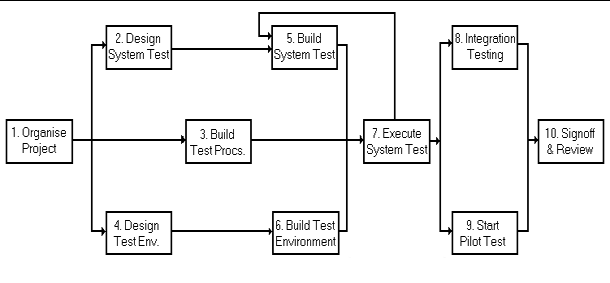Sample Test Plan
Chapter 3 - Test Phases and Cycles
3. TEST PHASES AND CYCLES
There will be two main stages of testing for the
new application during System Test :
- System Testing
- Operations Acceptance Testing
3.1. System Testing Cycles
The main thrust of the approach is to intensively
test the front end in the first two releases, thus raising approximately 80% of
errors in this period. With the majority of these errors fixed, standard and/or
frequently used actions will be tested to prove individual elements and total
system processing in Release v0.3. Regression testing of outstanding errors will
be performed on an ongoing basis.
When all errors (which potentially
impact overall processing) are fixed, an additional set of test cases are
processed in Release v0.4 to ensure the system works in an integrated manner. It
is intended that Release v0.4 be the final proving of the system as a single
application. There should be no A or B class errors outstanding prior to the
start of Release v0.4 testing.
3.1.1. Test Cases by Release version:
| Testing
by Phase |
|
| |
Acceptance
1 |
| Release v0.1 |
Functional
1 |
| |
User
Acceptance |
| |
Acceptance
2 |
| Release v0.2 |
Functional
2 |
| |
Regression
1 |
| |
Acceptance
3 |
| |
Functional
3 |
| Release v0.3 |
Performance
1 |
| |
Bash &
Multi-User Testing |
| |
Regression
1 |
| |
Regression
2 |
| |
Integration
1 |
| |
Technical
1 |
| Release v0.4 |
Regression
1 |
| |
Regression
2 |
| |
Regression
3 |
| |
Installation
Test |
| Contingency |
Per Bug Fix
Test Only |
3.1.2.
Automated Testing
Automated testing tools will be used in the test
environment for functional and regression testing. The main focus of the
automated testing will be the regression testing of the previously delivered
functionality - i.e. when development version 0.2 of the software is delivered
the majority of the regression testing of the functionality delivered in
development version 0.1 will be automated. It is estimated that the full benefit
of the automated testing will only occur when the tests have been executed three
or more times.
3.2. Software Delivery
During System Test the release of new versions of
the software will be co-ordinated between the Development Team leader and the
System Test Controller. However, unless it concerns a fix to a very serious
error, new versions should only be released when a agreed targets have been
reached (i.e. the next version contains fixes to X or more numbers of bugs).
Release Schedule:
Functionality
to
be Delivered * |
v0.1
1st May |
v0.2
17th May |
v0.3
31st May |
v0.4
18th June |
v1.0
29th June |
| 1. Function
A |
|
|
|
|
|
| 2. Process
B |
|
|
|
No
New |
Bug
Fix |
| 3. Euro
Reqs' |
|
|
|
Functionality |
contingency |
| 4. Y2K
Reqs. |
|
|
|
to be
|
release |
| 5. Inter
Office Trans |
|
|
|
delivered |
only. |
| 6.
International Trans. |
|
|
|
in
this |
|
| 7.
Other. |
|
|
|
release. |
|
* (per functional spec, by priority)
Notes:
It is intended that
80% of the functionality will have been tested in full prior to the Phase 3
Release.
All the functionality must be present in the Phase 3 Release.
No previously undelivered functionality will be accepted for testing after
Phase 3.
3.3. Formal ReviewingThere will be several
formal review points before and during system test, including the review of this
document. This is a vital element in achieving a quality product.
3.3.1. Formal
Review Points

1. Design Documentation - Requirements
Specification & Functional Specification
3. Unit Test Plans & Test
Conditions
5. System Test Conditions
6. System Test Progress/Results
7. Post System Test Review
8. Integration Test Results
9. Pilot Implementation Review
The diagram above outlines the Test Approach.
Boxes 1 - 6 show the major review stages prior to Test execution. Boxes 7 - 10
show the phases planned for & after test execution.
While the above diagram concentrates on the
testing aspect of SQA's role, there is an ongoing role also, in ensuring the
quality of the major deliverables throughout the lifecycle of the project. SQA's
role will be to ensure that all Quality Inspections occur for all the agreed
deliverables and that follow up actions and initiatives are pursued.
3.3.2.
Progress/Results Monitoring
- Acceptance Test 1 Results
- Test Results - Release v0.1
- Test Results - Release v0.2
- Test Results - Release v0.3
- Performance Test 1 Results
- Regression 1 & 2 Results
- Test Results - Release v0.4
- Technical Test Results
|